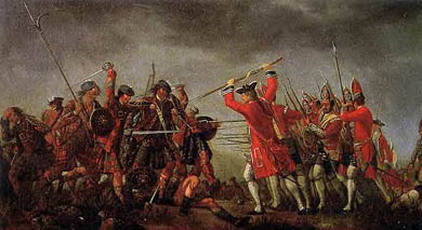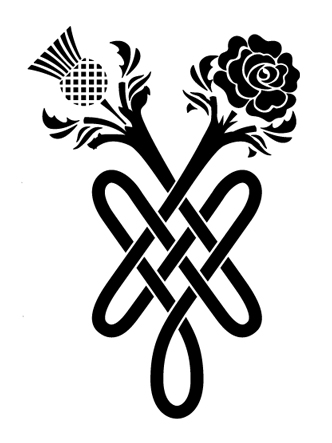
The Jacobites were the supporters of King James II of England, who was also King James VII of Scotland, and his heirs.
After the death of his brother Charles II, James II ruled Britain from 1685 to 1689. He was hugely unpopular, because of his absolutist behaviour (the sort which had cost his own father his head) and also because he was a Roman Catholic.
The English parliament was not prepared to tolerate this behaviour and invited James’s daughter Mary and her husband, the Dutch Prince William of Orange to replace the king.
William of Orange accepted the invitation from the English parliament in November 1688. James did not attempt to fight for his crown and fled the country instead. William became William III of England, ruling jointly with his wife. In Scotland it took until April 1689 to recognize William as King of Scotland.
Those who continued to support the exiled King James became known as Jacobites. Their name was derived from Jacobus, the Latin version of James.
In 1689, the Jacobites were opposed by the Whigs, those Britons who supported the Protestant cause and were not prepared to tolerate a Catholic kingdom.
There were three main Jacobite risings.
The 1689 rising was led by Bonnie Dundee, John Graham of Claverhouse. He was outraged at the notion of accepting William of Orange as his king, and raised a small army of which he was commander. His spectacular victory against the Williamite army at Killiecrankie was won at the cost of his own life. He was killed at the moment of victory. Thereafter the rebellion was quickly quelled.
Mar’s Rebellion, or the Fifteen, in 1715 was provoked by the death in 1714 of the last Stuart monarch, Queen Anne, and the subsequent accession of the Hanoverian King George I. The Jacobite standard was raised on 6 September 1715 in the north-east Highlands. There was widespread support for the rebellion and the Jacobites vastly outnumbered the British government forces. The campaign was not well organised and the exiled Stewart 'king', James VIII, did not land in Scotland until 22 December by which time the government had regained the initiative. On 4 February 1716 James admitted defeat and returned to France.
The final Jacobite rebellion, the Forty-Five, took place in 1745 when Charles Edward Stuart, Bonnie Prince Charlie, led an army against the Hanoverian King George II. It is this rebellion that is the backdrop for A Kiss for a Highlander, the first book in my Georgian Rebel Series coming soon from Samhain Publishing.
Jacobite Pinterest board:
http://www.pinterest.com/JaneGodman/jacobites/
After the death of his brother Charles II, James II ruled Britain from 1685 to 1689. He was hugely unpopular, because of his absolutist behaviour (the sort which had cost his own father his head) and also because he was a Roman Catholic.
The English parliament was not prepared to tolerate this behaviour and invited James’s daughter Mary and her husband, the Dutch Prince William of Orange to replace the king.
William of Orange accepted the invitation from the English parliament in November 1688. James did not attempt to fight for his crown and fled the country instead. William became William III of England, ruling jointly with his wife. In Scotland it took until April 1689 to recognize William as King of Scotland.
Those who continued to support the exiled King James became known as Jacobites. Their name was derived from Jacobus, the Latin version of James.
In 1689, the Jacobites were opposed by the Whigs, those Britons who supported the Protestant cause and were not prepared to tolerate a Catholic kingdom.
There were three main Jacobite risings.
The 1689 rising was led by Bonnie Dundee, John Graham of Claverhouse. He was outraged at the notion of accepting William of Orange as his king, and raised a small army of which he was commander. His spectacular victory against the Williamite army at Killiecrankie was won at the cost of his own life. He was killed at the moment of victory. Thereafter the rebellion was quickly quelled.
Mar’s Rebellion, or the Fifteen, in 1715 was provoked by the death in 1714 of the last Stuart monarch, Queen Anne, and the subsequent accession of the Hanoverian King George I. The Jacobite standard was raised on 6 September 1715 in the north-east Highlands. There was widespread support for the rebellion and the Jacobites vastly outnumbered the British government forces. The campaign was not well organised and the exiled Stewart 'king', James VIII, did not land in Scotland until 22 December by which time the government had regained the initiative. On 4 February 1716 James admitted defeat and returned to France.
The final Jacobite rebellion, the Forty-Five, took place in 1745 when Charles Edward Stuart, Bonnie Prince Charlie, led an army against the Hanoverian King George II. It is this rebellion that is the backdrop for A Kiss for a Highlander, the first book in my Georgian Rebel Series coming soon from Samhain Publishing.
Jacobite Pinterest board:
http://www.pinterest.com/JaneGodman/jacobites/




 RSS Feed
RSS Feed
